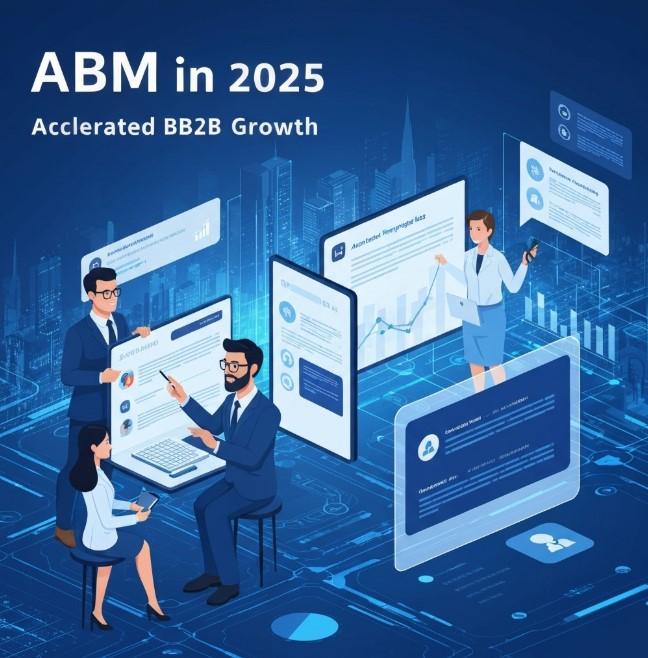ABM in 2025: Redefining B2B Growth with Precision Targeting

Account-Based Marketing (ABM) has evolved from a niche strategy into a core pillar of B2B demand generation. In 2025, ABM is no longer just about targeting a list of accounts — it’s about orchestrating personalized, AI-driven experiences that influence buying committees across multiple touchpoints.
In today’s hyper-competitive landscape, B2B buyers expect personalized engagement that speaks to their business goals, pain points, and industry challenges. ABM empowers marketing and sales teams to align on shared revenue goals, create tailored campaigns, and close deals faster with higher ROI.
This article explores why ABM matters more than ever, the challenges B2B marketers face, proven strategies for success, and what the future holds in 2025.
What is ABM and Why It Matters
Account-Based Marketing is a targeted growth strategy in which marketing and sales teams collaborate to identify high-value accounts, build personalized campaigns, and nurture these accounts through the entire buyer journey.
Why ABM is critical in 2025:
- 🧭 Precision Targeting: Focus resources on accounts most likely to convert.
- 🤝 Sales-Marketing Alignment: Unified strategies increase conversion rates.
- 📈 Faster Deal Cycles: Personalized engagement accelerates decision-making.
- 💰 Higher ROI: ABM programs consistently outperform traditional lead gen.
- 🧠 Better Customer Experience: Tailored messaging builds trust and loyalty.
📊 Stat Insight: 87% of B2B marketers say ABM delivers higher ROI than other marketing activities (source: Demandbase).
Challenges in ABM for B2B Marketers
Even with its advantages, ABM can be complex to execute. Common hurdles include:
- Identifying the Right Accounts
- Targeting too broad or too narrow can dilute impact. Many marketers struggle to define clear Ideal Customer Profiles (ICPs) based on real buying signals.
- Sales-Marketing Misalignment
- If sales and marketing teams aren’t fully aligned on goals, KPIs, and messaging, ABM campaigns fail to generate meaningful pipeline.
- Data Quality and Intent Signals
- Poor data hygiene or lack of reliable intent data leads to targeting inefficiencies and wasted spend.
- Personalization at Scale
- Creating tailored experiences for hundreds of accounts requires advanced tech stacks and automation.
- Measuring Impact
- ABM success goes beyond vanity metrics; it requires tracking pipeline acceleration, engagement depth, and revenue influence.
Proven ABM Strategies for 2025
1. Define and Prioritize High-Value Accounts
Start with data. Use firmographics, technographics, and intent signals to build a clear ICP. Leverage predictive analytics to score and prioritize accounts with the highest likelihood of conversion.
2. Align Marketing and Sales Around Revenue Goals
ABM works best when both teams collaborate on:
- Account selection
- Content strategy
- Engagement plans
- Pipeline reporting
💡 Pro Tip: Weekly revenue sync meetings can keep both teams aligned and accountable.
3. Personalize Buyer Journeys
Move beyond generic messaging. Tailor campaigns to:
- Buyer roles (e.g., CMO vs. CTO)
- Industry challenges
- Funnel stage
This includes personalized landing pages, custom email sequences, and dynamic content.
4. Activate Multi-Channel Engagement
Meet decision-makers where they are:
- LinkedIn & paid social
- Targeted email campaigns
- Web personalization
- Programmatic ads
- Events and webinars
The goal is to build a connected experience across every touchpoint.
5. Leverage ABM Technology and AI
Modern ABM platforms integrate AI to automate personalization, optimize targeting, and provide actionable insights. Top tools include Demandbase, 6sense, and Terminus.
Trends Shaping ABM in 2025
- AI-Powered Targeting
- AI helps identify high-intent accounts faster, segment audiences dynamically, and deliver hyper-personalized experiences.
- Predictive Engagement Models
- Predictive analytics enables marketers to prioritize accounts showing real buying behavior.
- Full-Funnel ABM
- Instead of top-of-funnel focus, brands are applying ABM throughout the entire revenue journey — from awareness to expansion.
- ABM + PLG Convergence
- Product-led growth (PLG) and ABM are merging, allowing brands to combine free product experiences with targeted outreach.
- Data-Driven Personalization
- Real-time data triggers campaigns at exactly the right moment, increasing engagement rates and conversion velocity.
Pro Tips & Bonus Insights
- Use intent data to align campaigns with buyer research activity.
- Invest in sales enablement content specifically designed for ABM accounts.
- Build custom dashboards to track engagement, pipeline velocity, and revenue.
- Prioritize quality over quantity — fewer, high-impact accounts drive better ROI.
- Test and iterate — ABM success requires constant optimization.
Conclusion
ABM in 2025 is not just a marketing strategy — it’s a revenue engine that brings marketing, sales, and customer success together to drive growth. By focusing on the right accounts, leveraging AI-driven personalization, and delivering connected omnichannel experiences, B2B brands can close bigger deals, faster.
As competition intensifies, companies that master ABM will lead their categories, turning high-value accounts into long-term revenue champions.
- Art
- Causes
- Crafts
- Dance
- Drinks
- Film
- Fitness
- Food
- Games
- Gardening
- Health
- Home
- Literature
- Music
- Networking
- Other
- Party
- Religion
- Shopping
- Sports
- Theater
- Wellness


